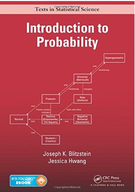A jar contains r red balls and g green balls, where r and g are fixed positive integers
Chapter 1, Problem 31(choose chapter or problem)
A jar contains r red balls and g green balls, where r and g are fixed positive integers. A ball is drawn from the jar randomly (with all possibilities equally likely), and then a second ball is drawn randomly. (a) Explain intuitively why the probability of the second ball being green is the same as the probability of the first ball being green. (b) Define notation for the sample space of the problem, and use this to compute the probabilities from (a) and show that they are the (c) Suppose that there are 16 balls in total, and that the probability that the two balls are the same color is the same as the probability that they are dierent colors. What are r and g (list all possibilities)?
Unfortunately, we don't have that question answered yet. But you can get it answered in just 5 hours by Logging in or Becoming a subscriber.
Becoming a subscriber
Or look for another answer
